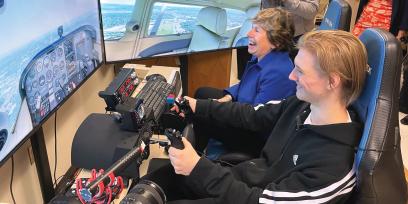In his 2024 State of the Union address, President Biden said one of his key economic and educational priorities was “Connecting businesses and high schools so students get hands-on experience and a path to a good-paying job whether or not they go to college.”
It’s a watershed moment. A US president talking not about standardized test scores, but about the promise of career pathways—taking career and technical education (CTE) off the sidelines and making it a priority in high schools. And involving businesses—small and large—in students’ lives, not as an afterthought, but as a means of giving students internships and future choices.
The American public education system, at least its educators, wants this. I see it in schools I’ve visited across the country: CTE is transformative—not only for students, but for American education itself.
For decades, policymakers saw preparing all kids for college as the mission of public schools—thus the obsession with reading and math scores. What laws like No Child Left Behind really left behind was the true purpose of public education: to prepare kids for everything—life, career, college, civic engagement.
Then came two social upheavals: the pandemic and AI. The pandemic confirmed that relationships and problem solving, not test prep and memorization, are critical for learning. The artificial intelligence challenge for students and educators is to harness the good and prevent AI from exacerbating the harms of social media.
We have to meet this moment. Experiential learning—project-based, hands-on learning, of which CTE is a prime example—gets kids engaged. It lifts attendance and expands workforce training. It makes public schools places where parents want to send their children, educators want to work, and students thrive. And it boosts the economy. It’s truly a win-win-win for individuals and for America.
These days, CTE prepares students not only for highly skilled trades, like carpentry and auto repair, but also for careers in healthcare, transportation, culinary and hospitality, graphic design, and now advanced manufacturing. The Biden administration’s historic investments in American manufacturing and infrastructure are creating high-paying, high-demand jobs that don’t require a four-year degree. (It’s part of Biden’s effort to grow the economy and reshape it so that workers, not just the wealthy, prosper.) But CTE isn’t merely an alternative to college. Far from it. CTE gives all kids tools for success in life, like working in teams, thinking critically, and meeting deadlines. Of students who concentrate in CTE, 94 percent graduate from high school and 72 percent go on to college.
CTE is a game-changer—that’s why we devoted this whole issue to it. As you’ll see, CTE today means:
- Trailblazing partnerships: I was honored to be with President Biden in April as he announced a multibillion-dollar federal investment for Micron to build microchip plants in Clay, New York, and Boise, Idaho, creating 70,000 jobs. The AFT and our New York affiliates are working with Micron and New York state to develop a curriculum framework to prepare students for a variety of good jobs in advanced manufacturing.
- Career exploration and academics: At Salem High School in Massachusetts, CTE is integrated with academic standards; students engage in advanced coursework and develop transferable skills while preparing for jobs, apprenticeships, and college. Its 10 CTE programs feature everything from restaurant-grade induction cooktops to virtual dissection tables and are guided by advisory boards of business leaders and union and postsecondary representatives.
- A head start on healthcare professions: Cleveland’s Lincoln-West School of Science and Health partnered with Cleveland’s MetroHealth main hospital to create a high school housed in a hospital. Students learn firsthand about hospital careers and work with healthcare-professional mentors. Our union is helping seed more of these programs—including the Northwell School of Health Sciences in Queens, New York—by partnering with Bloomberg Philanthropies.
- An entree to maritime careers: At New York City’s Harbor School, students have eight pathways leading to good jobs in marine science, technology, or policy. Students learn to captain boats, build submersible robots, participate in oyster restoration, and prepare for careers protecting our waterways. Keeping multiple pathways open, they also study traditional academics.
This important work exemplifies what the AFT is fighting for: real solutions to help students thrive, by transforming education and building a better life for all. CTE does just that—and points the way to transformative change in American education.
[Photo by the AFT]

